| Columns Retired Columns & Blogs |
Next HR is gonna review PS Audio Stellar Strata ($3,000) and NAD M33 ($5,000) integrated amps :-) ......
When I performed the measurements of the original Rogue Sphinx integrated amplifier to accompany Herb Reichert's review in the August 2014 issue of Stereophile, I was impressed by what I found. "Even without taking into account its affordable price, Rogue Audio's Sphinx offers excellent measured performance with little sign of the usual compromises made in class-D designs," I concluded, adding that it "also has an excellent, moving-magnet–compatible phono stage." Herb reports in this issue on the sound of the new V3 version of the Sphinx, which features a new phono stage that can be switched between moving-coil and moving-magnet operation.
Editor Jim Austin suggested that I should examine the V3's measured performance, so I hooked up Herb's sample (serial number 3057) to my Audio Precision SYS2722 system (see the January 2008 "As We See It"). As the Sphinx V3, like its predecessor, has a class-D output stage—the amplifier uses a pair of Hypex UcD-180 modules—I used a precision passive low-pass filter from Audio Precision to eliminate ultrasonic noise that would otherwise drive the analyzer's input stage into slew-rate limiting.
Examined first at its line inputs, the V3 offered slightly higher maximum gain than the original Sphinx, 32.7dB into 8 ohms vs 31.16dB, but still with excellent matching between the channels. The input impedance was similarly high, at >100k ohms, and the amplifier preserved absolute polarity at all four sets of outputs—loudspeaker, headphone, and variable and fixed-level preamplifier. The loudspeaker terminals' output impedance was still very low, at 0.04 ohms at 20Hz and 1kHz, rising only slightly to 0.1 ohm at 20kHz.
I didn't look at the performance of the Sphinx as a headphone amplifier in 2014, as Herb hadn't auditioned it with headphones. The 2020 Sphinx's headphone output offered a maximum gain of –1.8dB—ie, a line input level of 1V gave an output at the headphone jack of 814mV—sourced from a very low impedance of <1 ohm. The V3 will thus have no problem driving low-impedance headphones. While the line-output frequency responses of both the original Sphinx and the V3 rolled off in the low bass, reaching –2dB at 10Hz (fig.1, blue and red traces), the headphone output on the V3 was flat to 10Hz (fig.1, green and gray traces). It also extended slightly higher at the other end of the spectrum, reaching –3dB at 50kHz (right) and 60kHz (left). Distortion was low at the headphone output, all the harmonics lying below –106dB (0.0005%) ref. 1V into 300 ohms, with the third harmonic slightly higher in level than the second.
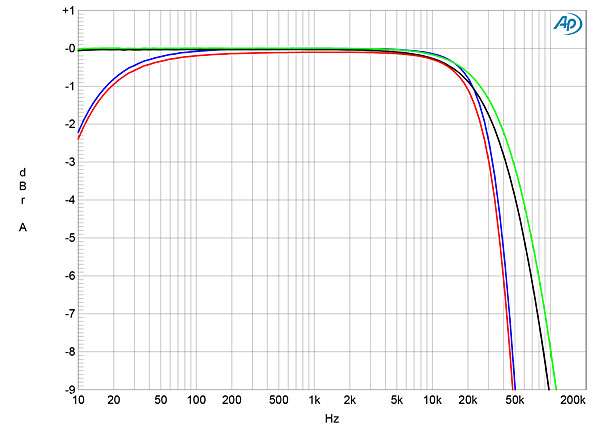
Returning to the V3's performance at the loudspeaker outputs, channel separation (not shown) was the same as before, at 60dB in both directions below 1kHz and around 40dB at the top of the audioband. The V3's unweighted signal/noise ratio in the audioband, taken with the line input shorted but the volume control at its maximum, was also the same at 67.7dB left and 66.1dB right, both ref. 2.83V into 8 ohms. This was primarily due to full-wave–rectified, supply-related spuriae (fig.2), though the random noise floor components were also relatively high in level.
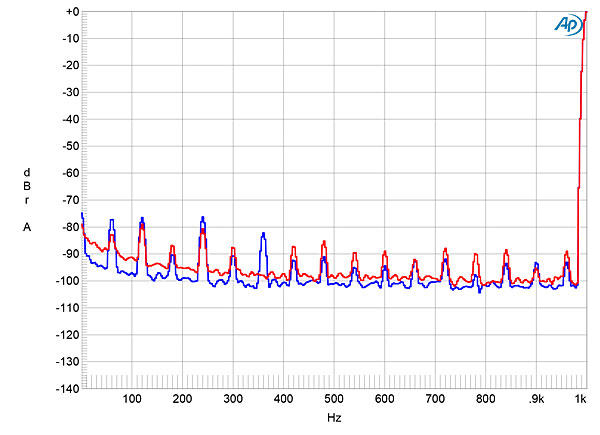
While the original Sphinx met its maximum power specification of 100Wpc into 8 ohms (20dBW) at 1% THD+noise, the V3 fell just short, delivering 96Wpc into 8 ohms (19.82dBW, fig.3). Into 4 ohms, the new amplifier clipped at 150Wpc (18.75dBW, fig.4) compared with the original's 155W (18.9dBW). The distortion was very low at powers up to a few tens of watts into either load, however, and was predominantly the subjectively innocuous second harmonic.
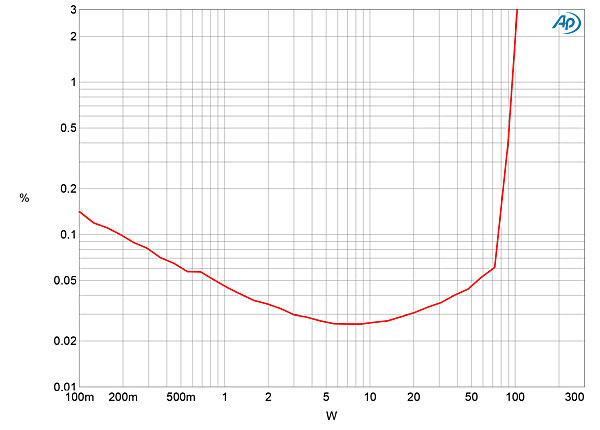
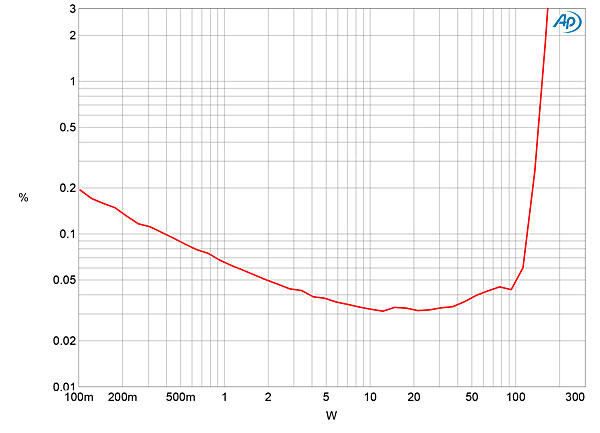
I measured the behavior of the original Sphinx's phono input at the fixed-output jacks with the volume control set to its minimum so that I could keep the output stage quiescent. (The fixed-level output operates at unity gain for line-level inputs, though the variable preamplifier output offered a small maximum gain of 1dB.) However, I ran into trouble with the V3, as there was a fairly high level of ultrasonic noise at the fixed and variable preamplifier outputs, even with the amplifier's grounding post connected to the analyzer ground. (Peculiarly, this noise was much lower in level when I changed from moving-magnet to moving-coil mode with the internal switches.) I therefore examined the phono input's behavior primarily at the headphone output.
Set to MM, the phono input preserved absolute polarity and offered a maximum gain of 43.3dB at the headphone output, though the maximum gain at the loudspeaker terminals was a high 77.7dB. With the internal switches set to MC, the maximum gain was 12dB higher, which is appropriate for all but low-output moving-coil cartridges. With the phono stage's input impedance set to 47k ohms, I measured 45k ohms at 20Hz, 47k ohms at 1kHz, and 42k ohms at 20kHz. With the impedance set to 300 ohms, I measured 299 ohms from 20Hz to 20kHz. All the other input impedances also closely matched the nominal values.
Measured at the fixed preamplifier outputs, so I could accurately capture the response above the headphone amplifier's ultrasonic rolloff, the V3's RIAA correction was not quite up to the standard set by the 2014 Sphinx, with a mismatch of up to 0.9dB in the treble (fig.5). The bass rolls off early, conforming to the IEC modification of the RIAA specification, though it reaches –3dB at 30Hz compared with the original's 11Hz. Channel separation via the phono input was also not quite to the standard set by the original Sphinx, at 50dB right-to-left and 67dB left-to-right at 1kHz. The phono input's noise performance in MC mode was good, with unweighted audioband signal/noise ratios (ref. 1kHz at 5mV input signal) of 52.5dB (average of both channels). The ratios improved by 6dB when A-weighted.
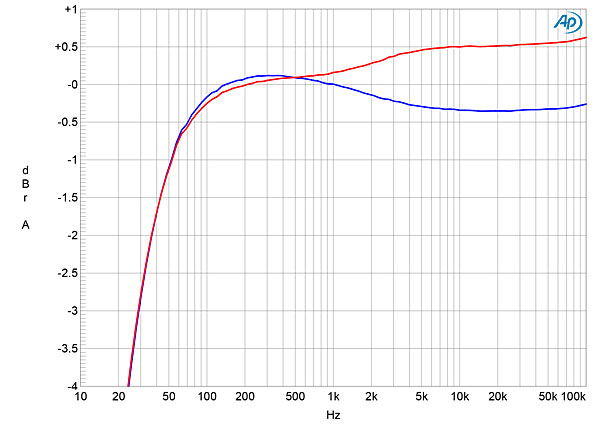
As with the first version of the Sphinx, the V3's phono input offered superb overload margins, close to 29dB across the band in MM mode and 20dB in MC mode. Distortion at typical recorded levels was low (fig.6). Though some high-order harmonics are present in this graph, these all lie at or below –84dB (0.006%). Intermodulation distortion via the phono input was also low (fig.7), though low-level, supply-related components can be seen.
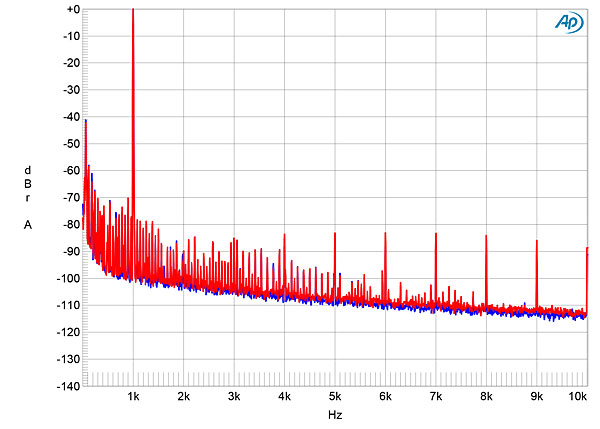
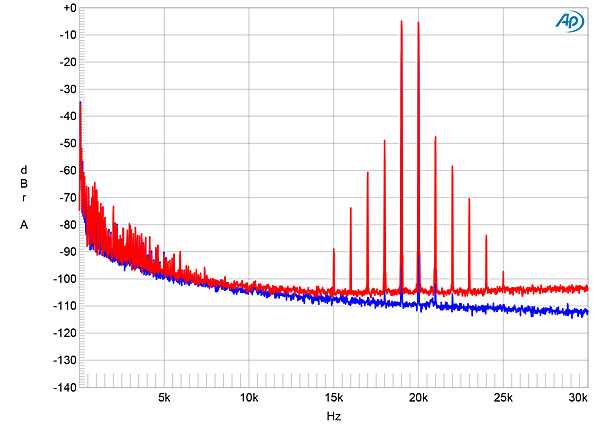
As a line-level integrated amplifier and headphone amplifier, the Sphinx V3 continues the high standard set by the original. The addition of an MC mode to the phono stage is welcome, though I was puzzled by the noise problem I found at the preamplifier outputs with the MM mode.—John Atkinson

Next HR is gonna review PS Audio Stellar Strata ($3,000) and NAD M33 ($5,000) integrated amps :-) ......

Next HR is gonna review PS Audio Stellar Strata ($3,000) and NAD M33 ($5,000) integrated amps
Kal Rubinson reviews the NAD M33 in the October Stereophile. Don't know what the plans are for a review of the PS Audio Stellar amplifier.
John Atkinson
Technical Editor, Stereophile

PS Audio Stellar Strata offers 3 user selectable digital reconstruction filters in the built-in DAC ..... It also offers headphone output ..... NAD M10 doesn't offer those :-) ......

Great .... I know KR is gonna do a great job reviewing the NAD M33 ..... Hope he tries the Dirac Live ...... Dirac Live is available for full audio frequency in M33, unlike the M10, where it is only available up to 500 Hz ...... Looking forward to reading KR's review .......
You (JA1) could review the Stellar Strata and compare it to NAD M10 :-) .....

The Sphinx still has abominable bass rolloff and doesn't meet claimed power specs. Why this amp continues being lauded throughout the audio press is a mystery.

I think that statement is a bit extreme. 1dB down at 20hz is likely to not be noticeable in a regular listening room.

I owned the V2 and the lack of extension is quite obvious with any full-range speaker. $300 integrateds can do much better. It didn't sound anything like a tube amp either. It's not the value proposition that reviewers allege. The Yamaha A-S801 is far and away a better amp and priced lower. I dare Stereophile to put a Yamaha on their test bench. The results will embarrass many of the four-figure amps that have graced these webpages.

I'm as curious as you are why Yamaha amps are not reviewed in Stereophile. While I have never owned the Sphinx I still don't think 1dB is a big deal. What speakers were you powering?

I'm as curious as you are why Yamaha amps are not reviewed in Stereophile.
Jason Victor Serinus reviews the Yamaha A-S3200 integrated amplifier in the September issue.
John Atkinson
Technical Editor, Stereophile

If I had a choice, I would spend $1k more and buy a Mark Levinson 5805 (reviewed by Stereophile) instead :-) ......

... I'd spend 1K less and buy the Yamaha: It has tone and balance controls, which Mark Levinson could easily do, but won't because they just aren't cool enough for the stuffy purists who like to spend that much money, and who have made it politically incorrect to expect them
That review will be something to look forward to.

If I had more money, I probably would buy the Yamaha NS-5000 speakers ...... NS-5000 had received many favorable reviews :-) ......

...and the Dutch & Dutch 8C will exhibit better control over directivity, will exhibit a more smooth horizontal polar response, with radiation toward latteral first reflection regions being more similar to direct response, taking advantage of the psychoacoustics, physical psychology of human hearing perception in helping human listeners ignore those latteral first reflections regardless that the reflections exist within the sound field at the listening position.
Also, the D&D 8c is designed to be placed in close proximity to the room boundary behind the loudspeaker, allowing easier placement in modest sized listening rooms.
The ~$2.5k difference is more than enough to pay for a $2.2k PSI Audio AVAA C20 to place on the floor in a corner in the room.

If I want to use my beloved 300B single ended, class-A, triode tube amp, I can use it with the Yamaha speakers ...... I can't do that with D&D 8c ...... Just kidding ....... I don't own a beloved triode tube amp :-) .......

I guess it'd be the sound, the feature set (or delightful lack thereof) the build quality and made in PA, USA by a small passionate team that you can actually communicate with and stellar customer service. Yup, that'd 'bout cover my reasons.

... $1,599 Denon PMA-1600NE.
http://www.novial.sk/documents-denon/denon-pma-1600ne-hifi-choice-2017.pdf

I've had to expand the sources of information I rely on. It's unfortunate that Audio Excellence Canada, What Hi-fi, Audio Bacon, and others don't have measurements, but that's the way it goes. No, you won't be seeing that review here.

... can be found elsewhere:
https://audio.com.pl/testy/stereo/wzmacniacze-stereo/2855-denon-pma-1600ne#laboratory
https://www.i-fidelity.net/testberichte/high-end/denon-pma-1600ne/seite-6-labor.html

Audio Science Review is also a good source for measurements of miscellaneous gear submitted by readers.
Distortion on the Denon looks a little too high for my tastes. Although that doesn't always tell you everything.

Their recent 'review' of the AQ Victoria cables were rife with bias and prejudice. Negativity abounded before he even tested.
Moreover, he physically broke into the product and tried to make some silly generalizations, which I found offensive and presumptuous. In fact, all of the posters in the site come off like flat-earthers and sycophants and only further the agenda of their lead tester.
It would also appear that they never listen to their products under review- only test. This is a huge disservice and dishonest to respective buyers of gear under test. They create implications that 4-figure gear is on par with sub-$200 gear sound-wise, when the only data they have are measurements and no listening experiences to support or refute that data.

... the measurements are still good. Compare the Zero Fidelity rave review of the Iota VX amplifier with the ASR measurements. Very useful. Granted, the reviewer has biases. Who doesn't?
As for AUdioquest, I'm biased against them myself, and will never buy another one of their products -- because of my experience with them. They make claims about "high purity" metals, but, unlike other companies, won't say what degree of purity they use -- and they make many other similar, unsubstantiated claims. They further try to get potential buyers to think that each step up their chain represents an increase in quality or sound. B______t. I bought a $1000+ Diamond coaxial cable, and later found that both DH Labs and Blue Jeans, at 1/10 the price, sounded better. The Audioquest, even after a period of use, overemphasized the upper treble frequencies and sounded harsh. The other two sounded smoother and more realistic while still having just as much detail. So I'm all in with anyone who is biased against Audioquest. I'm sure they make SOME good products. I still have their Volcano speaker cable from maybe 20 years ago, and might still use it sometime. But their prices and their BS are too much for me these days.

and one would deduce that from a measurements-only site, they have an agenda they are trying to push. That's not transparent, and not even close to what Stereophile does adhere. It's worse than disbelieving subjective review sites- Way worse to make judgments that they don't have the power or the insight to infer! It's the inverse of the same BS propaganda you claim Audioquest is guilty.
Are you sure your system doesn't have already way too much treble content that all-silver Diamonds would exacerbate? Perhaps that's why copper and silver-plating sound better in your system? Keep the conspiracy theories to politics.
I've owned DH Labs cabling as well- their silver cartridge leads are almost as good as Oyaide's and almost as expensive(!). I'm sure they're both solid companies. i've also built my own Belden cable that sounded really bright.
Of course people that can't afford AQ will gravitate to a home-spun company charging a fraction of the cost and claim it's better. They also don't provide measurements to back up their claims! Their website reflects their low-margin aspirations. Making cables in your basement doesn't cost much indeed.
I'm gonna guess you feel DBS is BS, but Shunyata owns very similar, more elegant tech (Zitron) that is also patented and very expensive, and has seen a large upward 'model-shift'. (Their Cobra cabling used to possess Zitron, and now it is pushed one level above and much more expensive (speaker cables only- the newer Delta interconnects may support Zitron.) Even Shunyata's lowest Venom line has now seen a huge increase in pricing due to cyro technology making it to the line. I love the Venom speaker cables, hate the interconnects and want the cyro tech for my cables... after the fact. I can't without re-buying. (I won't.)
Those companies both know what those technologies wrought to the dielectric in cabling and taken their IP at a higher priced level to reflect that. There always will be high margins to pay for popular cabling people want, especially with technologies that only a scant few companies possess. Consumers are willing to pay more for those new and critical technologies. You're not. That's okay. It's not BS.
There is no way any one of us will ever have the privilege to discuss the protected intellectual property that Audioquest or Shunyata possesses. Despite Shunyata proving many of their technologies through measurements in the medical and audio field (certainly much more than Blue Jeans on every level), many feel they are dishonest or unproven. Sad.

Let's see: First, you IMAGINE what I might think about DBS, then argue against that; then you IMAGINE what my system might sound like, and argue against that. If you'd like to talk about the legitimate points I actually made, I could be willing to have that conversation. Otherwise ease off the substances a bit my friend.
As for Audio Science Review, whatever "agenda" they may have, they publish OBJECTIVE measurements. Those are a useful counterweight to listening-only reviews, as I mentioned vis-a-vis the IOTA VX review. So it's a perfectly useful site.
Best regards, LTL

No need for ad hominem attacks- I did not attack you.
No, but you gave nothing but other than stated that they were 'harsh' and spoke nothing of your 'experiences'. No legitimate points at all. If so, where??
And yeah, you said you were 'all for their biases' which includes DBS. I didn't IMAGINE anything. They speak directly to DBS, and I made reference in the 'review' BEFORE you responded to me in the first place.
No one saying that the ASR site isn't 'useful', but publishing OBJECTIVE measurements and then making jackass conclusions about it, doesn't help anyone.. it hurts them.

... longer than you've been a troll. Lol.
Were you actually contributing something substantive to the topic of this article?
No? Your attack also shows you to be disingenuous as well.

... not atypical compared to many other amps tested by the audio.com.pl site. According to their tests, if you want an amp with significantly lower distortion, either a Hegel or one of the NAD amps that use Hypex modules would meet that requirement.
In a Hi-Fi Choice group test, the Denon was preferred in the blind listening comparisons over a Hegel and an NAD (as well as amps from Yamaha, Technics and Arcam). The Denon and the NAD were both given a five star rating for sound quality, while the Hegel was close behind with 4 and a half stars. However, the NAD and the Hegel amps were judged to have poorer build quality relative to the Denon, Technics and Yamaha units.

"The Sphinx V3 is an old-school ... integrated amplifier with ... balance control (!!), ..."
The inclusion of a balance control doesn't deserve exclamation points. It should of course be there. Tone controls don't deserve them either.
The Parasound New Classic 200 integrated, at around this same price, has them all. Regardless of this rave review, I'd be more likely to buy the Parasound.


Thanks for your example of incorrect punctuation. Is there some point you're trying to make?

Telling Herb what does or doesn't "deserve" an exclamation point is hilarious!
Maybe Herb was having a bit of spirited fun as he wrote. I know, I am as out of control as him but I like a little wild use of punctuation from time to time. (see how I controlled my initial desire to punctuate that last sentence with an exclamation point? That was out of respect for you. I hope you appreciate that!
As I am trying to think of how (or why, even) to explain myself, it seems maybe you are correct after all.
He better get back in his seat and settle down or we're going to have a situation here.
And finally, I never use the balance control on my Sphinx and until V3 never had a remote. My dealer suggested that most folks like remotes so the amp will have higher resale if I ever choose to sell. But I guess it's nice for everyone who needs it. Still no tone controls for me, not even that Schiity thing.
.

Wonderful writing as always.
One of the best Debussy recordings I've heard is Children's Corner, Debussy Orchestrations by Orchestre Symphonique De Quebec (ATMA Classique). It ticks all the boxes: material, performance and recording quality. Absolutely gorgeous in all respects.

Recently replaced my 80s Levinson (ML-11/ML-10a) with a Sphinx V3. I also swapped the stock JJ's with Brimar cv4003's from Upscale Audio (more low end). It's absolutely amazing and I'm going to enjoy this for years (assuming it holds up). This is a perfect workhorse amp for intermediate audiophiles and/or someone that wants to dip their toes into tubes. I don't know why people keep saying a $1600 amp is entry level or affordable, but this is neither of those. This is a serious, thoughtful, piece of equipment and you can tell right out of the box (The Brimars take it to the special level IMO).


I'm biased, like my V3 a lot, a little tube rolling for fun.
I like the sound, the feature set the appearance, the build quality and it's made in PA, USA by a small passionate team that you can actually communicate with and stellar customer service. Great service really.
Tonight I am listening to 50th anniversary Workingman's Dead, 2-21-71 live show. Whew, that there's some beautiful sound and vibe!!!
PS - Keep using exclamation points they illustrate your enthusiasm! In fact, use extra!!! You are hereby granted unlimited punctuation use by the Noth Jersey division of The Art Police.

@JA
No old school squarewave responses John ...! :)

No old school squarewave responses John ...! :)
They're the same as shown in figs.2 and 3 at www.stereophile.com/content/rogue-audio-sphinx-integrated-amplifier-measurements.
John Atkinson
Technical Editor, Stereophile

That phrase puzzles me.
But I'm even more puzzled by something else. In his review of the original Sphinx, and in this review, the treble is never mentioned. Lots of nice adjectives describing the bass, a few for the midrange, but for the highs, only a cautious "didn't call attention to themselves." So: Great bass, OK mids, not such great highs. This sounds very much like Class D territory. Is that the case?

is one I 'imagine' a wage-earner with a 9-5 could aspire to owning.
"didn't call attention ro themselves" I choose my words carefully.
thanks for reading my prattles - I am honored
hr

Great review Herb. I just bought this amp in June to replace an old Rotel and I love this thing! I am grinning with every listen both on CD and LP, so I couldn't be happier. The internal phono stage is also fantastic...I am running a low-output MC Quintet Red and it sounds beautiful. I don't have thousands $$$ to blow on ultra pricey equipment and at $1600, frankly I don't need to. I went a bit over my budget and am so glad I did. I think this amp sounded better after about 7-10 days or so - it seemed to open up and have more air. This amp will keep my happy for many years to come. A+ 10/10.

I second the great review. I just had a HK990 go on the fritz and was looking around for a replacement. I read this review and thought the Sphinx would be a good choice and a lot less complex than the HK 990. I discovered that parts for the HK are non-existent, so repair was impossible. A very heavy paperweight! The Sphinx has exceeded my expectations in every way. Thanks Herb for the insightful review.